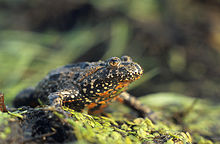Toad
| Toad | |
|---|---|
| Scientific classification | |
| Kingdom: | |
| Phylum: | |
| Subphylum: | |
| Class: | |
| Order: | Anura |

Toad is a common name applied to certain frogs, especially of the family Bufonidae,[1] that are characterized by dry, leathery skin, short legs, and parotoid glands.[citation needed]
Biology
A distinction between frogs and toads is not made in scientific taxonomy, but is common in popular culture (folk taxonomy), in which toads are associated with drier skin and more terrestrial habitats than animals commonly called frogs.[2] In scientific taxonomy, toads are found in the families Bufonidae, Bombinatoridae, Discoglossidae, Pelobatidae, Rhinophrynidae, Scaphiopodidae, and Microhylidae.[3] There is no definitive collective noun for toads, and like most collective nouns, the listed proposals are fanciful; one example is a knot of toads;[4] others include a lump, nest, or knob of toads. Between 1958 and 1960 Bogert recorded male toads in a field and it upheld to a gathering of female toads.[5]
Usually the largest of the bumps on the skin of a toad are those that cover the parotoid glands. The bumps are commonly called warts, but they have nothing to do with infectious warts, being fixed in size, present on healthy specimens and not caused by infection.[6][unreliable source?] Frogs travel from non-breeding areas to breeding areas of ponds and lakes. Bogert (1947) suggests that the call of the toads is the most important cue used by toads in the homing to ponds. Toads, like many amphibians, exhibit breeding site fidelity (philopatry). Individual Bufo americanus toads return to their natal ponds to breed where they are likely to encounter siblings as potential mates. Although inbred examples within a species is possible, siblings rarely mate.[7] Toads recognize and actively avoid mating with close kin. Advertisement vocalizations given by males appear to serve as cues by which females recognize kin.[8] Kin recognition thus allows avoidance of inbreeding and consequent inbreeding depression.
In human culture
Toads are often not distinguishable from frogs in popular culture, but Kenneth Grahame's Mr Toad in his 1908 novel The Wind in the Willows is a likeable and popular if selfish and narcissistic comic character. Mr Toad reappears as the lead character in A. A. Milne's 1929 play Toad of Toad Hall, based on the book.[9][10] In Chinese culture, the Money Toad (or Frog) Jin Chan appears as a Feng Shui charm for prosperity.[11]
See also
References
- ^ "toad". The American Heritage Dictionary of the English Language. Houghton Mifflin Harcourt. Retrieved 6 October 2016.
- ^ "Toad". Dictionary.com, LLC. Retrieved 29 May 2012.
- ^ "Anura, Taxonomic Serial No.: 173423". ITIS Report. Integrated Taxonomic Information System. Retrieved 20 April 2012.
- ^ Fellows, Dave (29 September 2006). "Animal Congregations, or What Do You Call a Group of.....?". United States Geological Survey, Northern Prairie Wildlife Research Center. Retrieved 20 April 2012.
- ^ Brattstrom, Bayard H. (1 January 1962). "Homing in the Giant Toad, Bufo marinus". Herpetologica. pp. 176–180.
- ^ Ray, Crystal. "Do Toads Really Cause Warts". Yahoo!. Retrieved 29 January 2013.
- ^ "American Toad". psu.edu.
- ^ Waldman B, Rice JE, Honeycutt RL. Kin recognition and incest avoidance in toads. Am. Zool. 1992. 32:18-30.
- ^ "The Big Read Top 200". BBC. April 2003. Retrieved 28 June 2016..
- ^ Christine Paik (2002-03-19). "NPR report". NPR. Retrieved 2013-02-26.
- ^ "Feng Shui Money Frog". Retrieved 28 June 2016.
External links
- Chisholm, Hugh, ed. (1911). . Encyclopædia Britannica (11th ed.). Cambridge University Press.
